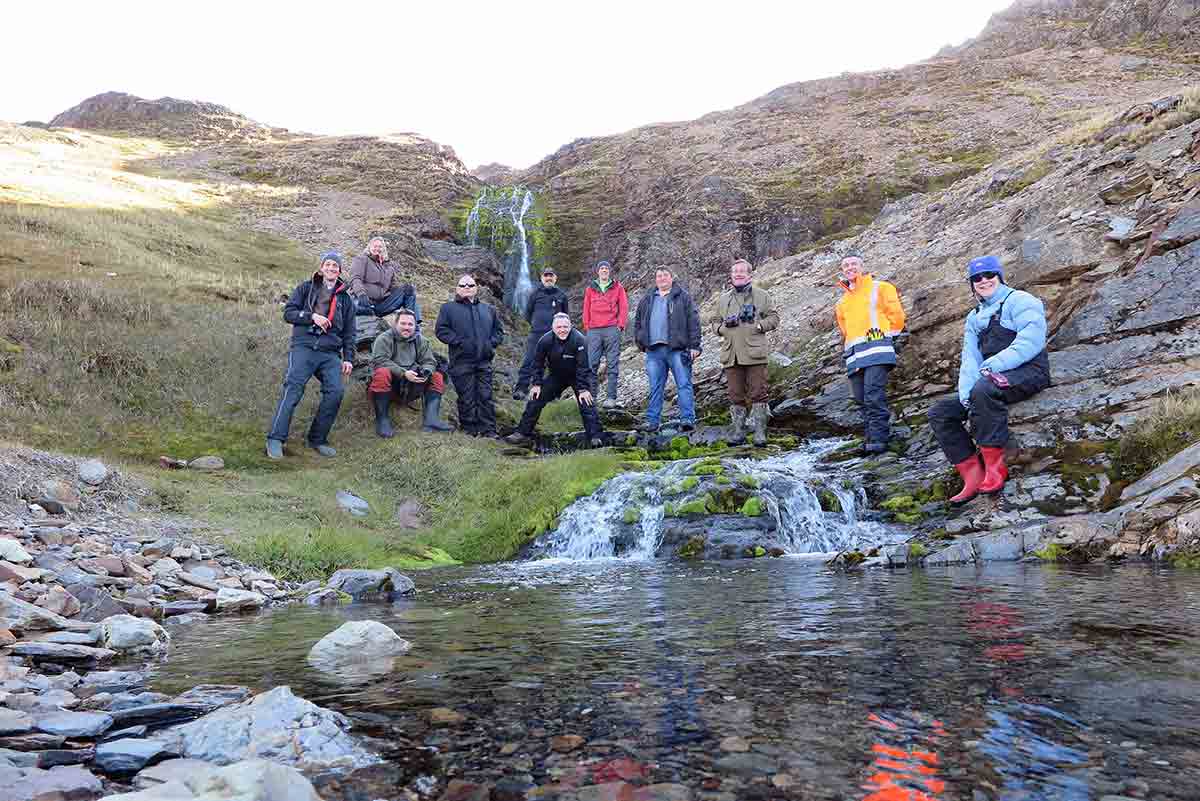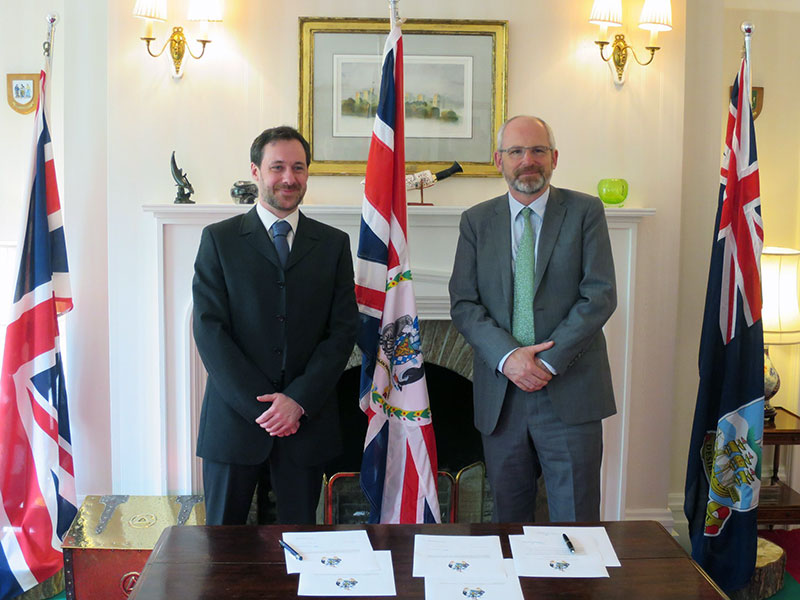The Commissioner for South Georgia & the South Sandwich Islands, Nigel Phillips CBE, returned on March 17th from his visit to South Georgia where he was accompanied by representatives of some of South Georgia’s key partners and stakeholders.
The visit took place on board, and was ably facilitated by, the Government’s vessel MV Pharos SG, and provided an opportunity to further existing collaboration and partnership through experiencing some of the shared challenges and opportunities facing our natural and cultural heritage. The Commissioner brought together representatives from stakeholders including the Falkland Islands Government, UK Parliament, British Antarctic Survey, Foreign & Commonwealth Office, International Association of Antarctica Tour Operators and Centre for Environment, Fisheries and Aquaculture Science, as well as the Rector of South Georgia. Discussions were framed by visits to some of South Georgia’s most significant wildlife and cultural heritage sites.
Participants arrived at GSGSSI’s administrative centre at King Edward Point and had the opportunity to meet staff from GSGSSI, British Antarctic Survey and the South Georgia Heritage Trust to see first hand the work being done to conserve both the natural and human heritage of the island. As well as a chance to see scientific study sites used by the British Antarctic Survey to monitor higher predators such as penguins and seals, the group were able to visit the tide water glaciers in Cumberland Bay which are retreating by up to 1m a day. The Rector took a rare opportunity to lead a Sunday service of Holy Communion at the old whalers church at Grytviken.
The visit incorporated landings along the coast including: Gold Harbour, home to 25,000 pairs of king penguins as well as elephant and fur seals; and Stromness, site of the abandoned whaling station which marked the end of Sir Ernest Shackleton’s epic traverse of South Georgia in 1916. Nearly 9,000 tourists visit South Georgia each year to visit sites such as these and with numbers due to grow further discussions considered some of the challenges of continuing to facilitate safe and sustainable tourism in the future, and approaches to managing the wildlife and cultural heritage in that context.
Constant companions on the voyage were the albatross. Visit participants got to see breeding sites first hand during landings on Prion Island and Bird Island, the latter the site of the British Antarctic Survey station and some of the longest-running environmental monitoring programmes in the Southern Ocean. Recent archipelago-wide surveys have shown that these iconic species are in decline. While independent observers confirm that none are being caught in South Georgia’s fisheries, incidental mortality associated with fisheries operating outside of the maritime zone is one of the likely causes. GSGSSI last year launched conservation plans to help better understand and address the threats to these albatross alongside efforts to continue enhancing bird by-catch mitigation practices on fishing vessels. Partnerships between Overseas Territories, UK Government, science organisations, fishery operators and the tourist industry are likely to be key to successful future conservation outcomes.
Biosecurity remained a strong theme throughout the visit with mandatory pre-arrival biosecurity checks to avoid the transfer of any non-native species to the Territory. This followed the ‘clearance’ of the vessel in Stanley by the GSGSSI’s rodent detector dogs which are taking part in a trial biosecurity programme based in the Falkland Islands. The dogs will operate on vessels departing for South Georgia from the Falkland Islands but will also be available to spend time internally in the Falkland Islands and at Mount Pleasant until mid-May.
The Commissioner was grateful to all the participants of the visit who gave a significant amount of their time in order to understand and contribute to the efforts of the Government of SGSSI to continually improve its management of a globally significant marine and terrestrial environment.
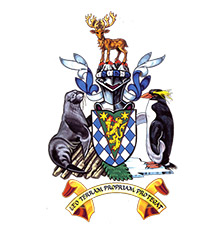 The 2017 Government of South Georgia & the South Sandwich Islands Annual Report has been published.
The 2017 Government of South Georgia & the South Sandwich Islands Annual Report has been published.
In his introductory message, SGSSI Commissioner Nigel Phillips CBE comments:
“Our actions are guided by our ambition for world-class environmental management. I am proud of the significant efforts towards this end made over many years by the Government and by a wide range of individuals and organisations with whom we collaborate. These have allowed us to develop a reputation as a leader in this field. I have been struck by the nature of these collaborations and the passion and dedication of so many to conserve and protect this important Territory. There is no complacency here and, as this report outlines, work continues on a number of fronts to further these efforts. This includes the first 5-year review of our Marine Protected Area which commenced in August, our work on biosecurity where we are building on our already comprehensive requirements, and the Marine Stewardship Council re-certification of our world-class toothfish fishery due to conclude in 2018. This report highlights the broad range of work with which the Government is engaged.”
The report can be downloaded here.
GSGSSI’s trial biosecurity detector dog programme, in association with Working Dogs for Conservation (WD4C), has started.
The dogs and handlers arrived from the US on 25th February and will be based in the Falkland Islands for 3 months. While in the Falklands they will undertook searches of vessels to ensure they are rodent free before setting sail to South Georgia. A wide range of vessels was searched, at anchor and alongside, including cruise ships, yachts, fishing vessels, and Government vessels. The presence of the team in the Falkland Islands provided the opportunity to collaborate with the Falkland Islands Government and British Forces South Atlantic Islands to deliver shared biosecurity objectives.
As part of the trial, WD4C will develop search protocols, training standards and risk assessments and then report back to GSGSSI on options for a longer-term rodent detection programme. They will also undertake a number of outreach activities in the Falkland Islands to raise awareness about biosecurity and look at potential for future long-term cross-territory collaboration.
The project is an important part of the enhanced biosecurity provision which is being put in place following recent work to eradicate invasive rodents on South Georgia by the South Georgia Heritage Trust (SGHT). It complements a comprehensive range of other pre- and post-border biosecurity measures GSGSSI already has in place and which are set out in its Biosecurity Handbook.
South Georgia Mapping Stamps
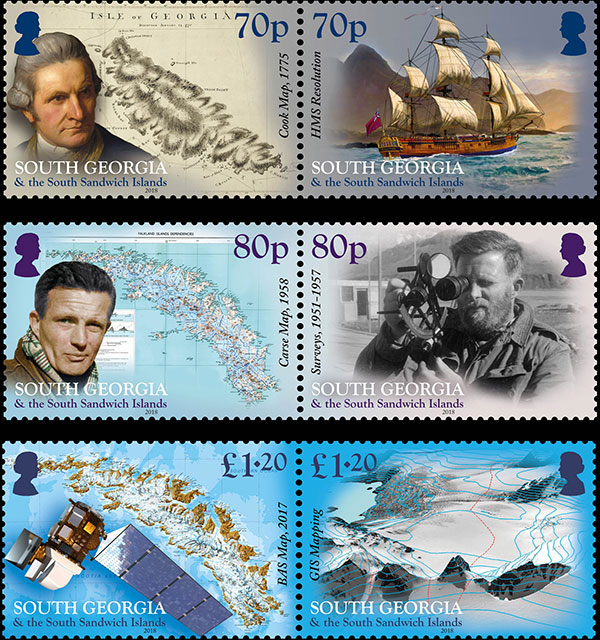 The Government of South Georgia & the South Sandwich Islands has launched a set of stamps celebrating the history of mapping the island.
The Government of South Georgia & the South Sandwich Islands has launched a set of stamps celebrating the history of mapping the island.
South Georgia is a mountainous, glaciated island in the South Atlantic. It has a rugged coastline and its highest peaks reach to over 2,935 m a.s.l., 8 % of the landmass is vegetated and there are numerous offshore islands and skerries. Each year more than 8,000 visitors come to the Territory, some enjoy short walks in the spectacular coastal scenery, others undertake ambitious expeditions into the islands interior, and all rely on accurate maps.
Detailed information about our surroundings is often taken for granted but it has taken nearly 250 years to accumulate such a thorough knowledge of the landscape. This information has been hard won and has a fascinating history. The stamps released today are in the format of three se-tenant pairs each celebrating an important development in the mapping of the Territory.
Further information on the stamps here.
Antarctic Fur Seals Stamps
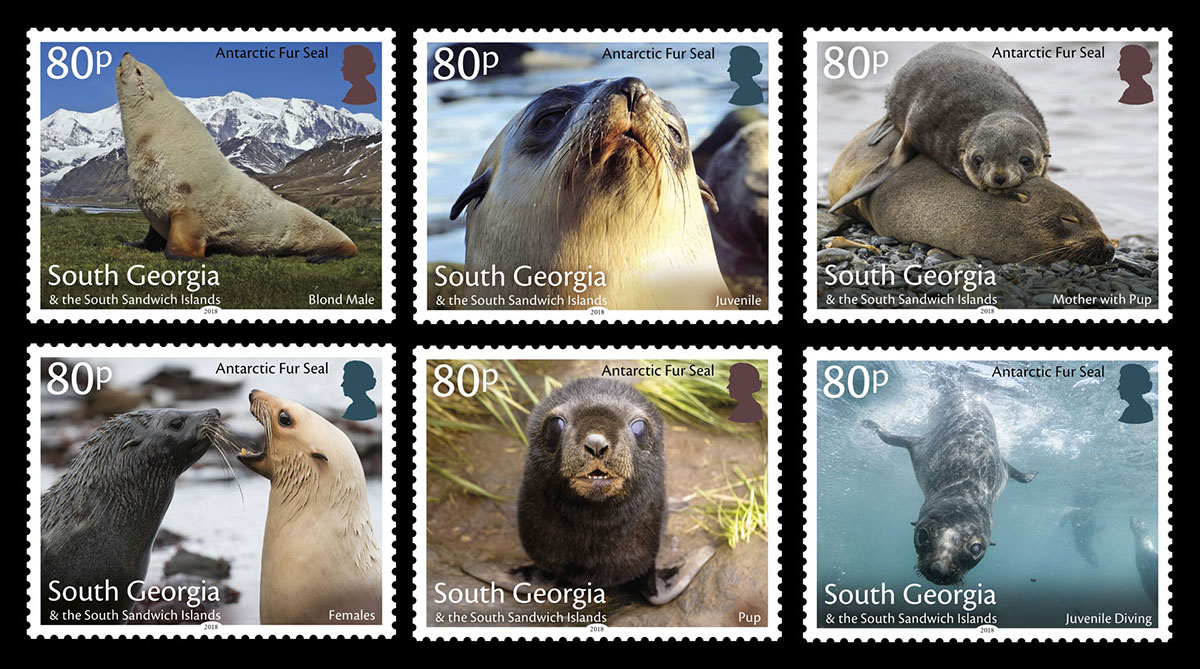 South Georgia stamps featuring Antarctic fur seals both on land and in the water at different stages though their lifespan has been issued.
South Georgia stamps featuring Antarctic fur seals both on land and in the water at different stages though their lifespan has been issued.
Antarctic fur seals are a member of the family Otariidae, or eared seals. Early explorers in the 18th century noted the abundance of fur seals on the coast of South Georgia and this soon lead to a lucrative and highly destructive industry. Sealing parties were primarily interested in the thick fur pelts and hunted seals to the brink of extinction. By the early 20th century, fur seals would have been a rare sight on South Georgia. Fur seals are now highly protected by domestic legislation, which makes it illegal to harm or disturb fur seals. International treaties, such as Convention on the International Trade in Endangered Species (CITIES), offers further protection by regulating trade of material between countries. Thankfully, populations have recovered and it is thought that nearly five million fur seals now live on South Georgia, which equates to 95% of the global population. In the summer months they are a common sight on beaches along the north coast and the air is filled with the sound of their calls.
More information on these stamps here.
Interview with Kieran Love, Zoological Field Assistant at King Edward Point Research Station (KEP) on South Georgia. From the orginal British Antarctic Survey blog here.
So, what does being a zoological field assistant involve?
My role is to maintain a long-term monitoring programme that focuses on the island’s higher predator species. Higher predators are animals that sit at the top of their food chains, at KEP they include Gentoo penguins and Antarctic fur seals. Typical tasks during the summer months (November to March) involve weighing fledging Gentoo penguin chicks and Antarctic fur seal pups.
Being the only zoologist at the station, I rely on all members of the team at KEP to assist me with these important surveys. It’s usually quite easy to get volunteers as everybody here is like-minded and enjoys working with the island’s charismatic wildlife. However, during March when the pups are close to weaning, they can triple in weight and develop quite an attitude so the volunteers sometimes need a little persuading with my homemade cake.
One of the essential parts of my job is to ensure the safety of the animals and personnel during surveys. This means that I’m responsible for overseeing all field surveys and appropriately training the other team members, who work at KEP as doctors, boating officers, technicians or other scientists.
Why do we monitor the higher predators at King Edward Point?
These higher predators are closely monitored to provide crucial information that contributes to the management of the region’s sustainable fisheries. In 2012, the Government of South Georgia and the South Sandwich Islands established the South Georgia and South Sandwich Islands Marine Protected Area (MPA). The MPA has been carefully designed to ensure the protection and conservation of the region’s rich and diverse marine life, while allowing sustainable and carefully regulated fisheries.
Gentoo penguins and Antarctic fur seals are krill-dependent species. By studying their population sizes, breeding success rates, body condition and diet we can gain valuable information on variability in krill abundance and ecology in the region. These data are used to inform approaches to the sustainable management of the krill fishery at South Georgia. Monitoring of the higher predator species, therefore, contributes to the responsible and sustainable management of the commercial fisheries around South Georgia. This is part of an ecosystem-based management approach which is supported by the Commission for the Conservation of Antarctic Marine Living Resources (CCAMLR) and forms a key part of the Antarctic-wide CCAMLR Ecosystem Monitoring Programme (CEMP).
What have this season’s surveys of the higher predator populations shown?
This season the fur seals are again reproducing in great abundance and showing consistently good puppy weights. This suggests that their mothers are foraging efficiently and have been providing good quality milk since earlier in December when pupping reached its peak.
Our Gentoo population has also showed a great number of returning breeders, with a record number of fledglings counted this month (February). On average the breeding success results in over one chick successfully raised per breeding pair. The average weight of fledglings is however at its lowest in the ten years of monitoring at KEP, which suggests high variability in local food availability. These indices of annual performance will now add to the long-term data set being recorded at KEP and complement the comparable results being collected at Bird Island.
Find out what the South Georgia Right Whale Expedition team have been up to during their first few weeks sailing in the waters around South Georgia. From the original British Antarctic Survey blog here.
Firstly, Susannah Calderan tells us what it has been like tracking southern right whales around South Georgia using their underwater vocalisations.
So far during our time in South Georgia the weather has been a challenge, we have had a combination of strong winds and fog which make it difficult to see animals. This makes it even more useful to be able to find whales by tracking their underwater vocalisations (Find out how we do this in one of our previous blogs).
As far as we know, the vocalisations of southern right whales in their feeding grounds, such as South Georgia, haven’t been recorded before, let alone used to track the whales. But we do know what sounds southern right whales make in their breeding grounds, and acoustic data is available from right whales in the Northern Hemisphere.
What we were expecting was a fairly limited repertoire of low frequency tonal sounds made infrequently and irregularly (unlike Antarctic blue whales, which are very reliable callers). The most commonly heard sound from right whales elsewhere is usually upcalls. These are brief sounds which rise slightly in frequency and sound like gulps; they are thought to be contact calls. Right whales also produce sounds called ‘gunshots’, a loud, broadband sound which sounds like a gun being fired. We also expected there might some confusion with humpback whales, whose vocalisations can sound very similar to those of right whales.
Acoustic tracking has gone really well so far. We have been able to identify southern right whale calls, resolve the direction they are coming from, and use those bearings to find the whales themselves. As anticipated, they don’t make calls very often, and we usually have to listen to our sonobuoys and watch the spectrograms – visual representations of the detected sounds – for several hours just to catch a few brief calls.
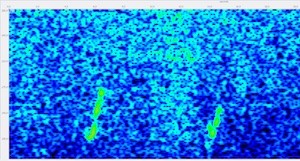
Right whale upcalls on spectrogram, showing change in frequency with time.

Right whale gunshot on spectrogram, showing change in frequency with time.
These can both lead us to the whales, and confirm that we have indeed been listening to right whales and not, for example, humpback whales. We are also, very importantly, characterising and starting to compile a record of the vocal repertoire of Southern right whales on their feeding grounds. Mostly we have detected upcalls and gunshots, and can probably hear whales that are around 10-15 miles away from our sonobuoy. Using our sonobuoy methodology to track and find southern right whales in real time is proving to be both tricky and exciting, and we’re very happy so far with the progress we’ve made.
Secondly, Dr Emma Carroll explains more about the importance of collecting skin samples from southern right whales during the expedition.
A major part of our work here in South Georgia is to collect small skin samples from the southern right whales we find. Skin samples are collected using a small dart fired from either a modified veterinary device or cross bow. The tip of the dart hits the whale and pulls out a small plug of skin about the size of your fingernail.
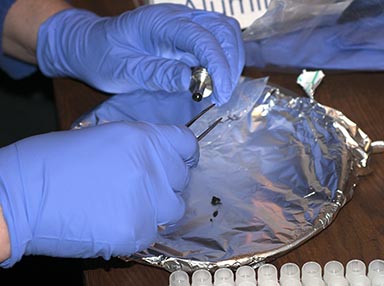
Collecting a skin sample obtained from a southern right whale. Photo Credit K. Jones
These little skin samples can tell us a lot about a whale: who they are, who they are related to, where and what they’ve been eating, and, if we get a bit of whale fat or blubber, we can also tell if they’re pregnant and how stressed they are. We get this information using different approaches. Firstly, we can get good quality DNA from these skin samples. Using DNA profiles, we can individually identify whales and their relatives. We are also planning on developing a way of ageing southern right whales using DNA over the next few years – excitingly, this has already been done for humpback whales. We can also compare the DNA profiles from whale samples around South Georgia with whales sampled around wintering grounds in Argentina. In this way, we can see if the same whales, or related whales, are visiting South Georgia in the summer and Argentina in the winter.
Next, we can use microchemical markers called stable isotopes in the skin to investigate whale diet. Stable isotope signals can vary predictably depending on things like latitude, how far off shore and the level of the food chain at which the whale is feeding. This enables us to investigate where and what the whales have been feeding on.
Blubber can also provide a lot of useful information about a whale, using hormone analysis. For example, we can look at the levels of a hormone called progesterone to see if the whales are pregnant. Another hormone, cortisol, can increase in response to stress. Some great work in North Atlantic right whales shows that there is chronic, high-level stress in whales living off the coast of USA. It will be interesting to see if the whales here are stressed, possibly due to fasting on their wintering ground, or not.
‘Team Rat’ hired by Dundee charity to give sub-Antarctic island the rodent all-clear
For most people, walking the dog is an opportunity for a bit of fresh air and gentle exercise. But for a team of 16 people hired by Dundee charity the South Georgia Trust there is a little bit more at stake — ensuring the sub-Antarctic island is free of rats so its natural wildlife can be restored.
Inside the eerie sub-Antarctic abandoned whaling station where more than 175,000 whales were slaughtered
The abandoned whaling station opened in 1904 and was one of the first in sub-Antarctic waters. It has a sinister feel with whale bones scattered like confetti, beached harpoon boats, and giant mechanical parts rusting in the chilling winds.
The Last Continent: Eradicating rats to save nearly extinct birds in one of the most remote places on Earth
This island is spectacular. Blizzards of small prions surrounded us in the air, while on the water, thousands more gorged on copepods along with other endemic birds — at least four different species of albatross, pintail ducks and others.
Daphne Bramham: Rats! They’re decimating the world’s seabirds
The Gwaii Haanas eradication was modelled on a successful project at Langara Island and on the largest-ever rat project in South Georgia, a 3,903-square-kilometre island, 2,050 kilometres southeast of Cape Horn.
Meet Quark Expeditions’ penguin expert
Penguinologist Dr Tom Hart on penguin behaviour, conservation and exploring South Georgia.
Antarctica’s king penguins ‘could disappear’ by the end of the century
Today’s report is the starkest warning yet of the potentially devastating impact of climate change and human exploitation on the Antarctic’s delicate eco-systems.
Antarctica: Journey to the bottom of the world
If you want to experience the best of the best, give yourself more time and look for trips that include South Georgia.
Leadership Lessons from Antarctic Explorers and Adventurers
Shackleton and a few companions traveled some 800 miles in an open boat to the South Georgia Island whaling station to obtain a rescue craft. He then returned to the Antarctic and rescued all of the stranded men.
Life in the ice wilderness
Despite being one of the most remote places on Earth, the glaciers of South Georgia Island are home to an abundance of life.
From an underwater letterbox in the South Pacific to a sorting room in Antarctica, the world’s most remote post offices revealed
Situated at King Edward Point, the sole post office on the sub-Antarctic island of South Georgia is run by a postal officer or appointed representative, and is open upon request.
The Last Continent: What does it mean to be a whale?
Postmedia columnist Daphne Bramham is on an 18-day expedition that crosses the notoriously rough Drake Passage from the Falkland Islands to South Georgia — known as the Serengeti of the Southern Ocean — to Antarctica.
South Georgia celebrated on 17 January “Possession Day”
On 17th January 1775 a small party of men landed on a beach beneath snowy peaks and tumbling glaciers. In charge was an officer by the name of James Cook; the British Flag was planted, a volley of musket shot was fired, and the land was claimed for His Britannic Majesty. Cook named the bay in which he landed Possession Bay. On the 17th January 2018 (and every year) South Georgia marked ‘Possession Day’ with a bank holiday and reception at Government House.
Expedition cruise vessel to be launched in 2020 will have its own submarine and helicopter
The Australian-owned cruise operator mentioned that the soon-to-be-launched 228-passenger Scenic Eclipse would be getting a sister in 2020 and it would be known as the Scenic Eclipse II. She is schedule to sail Falklands, South Georgia and Antarctica.
Share[addtoany]


